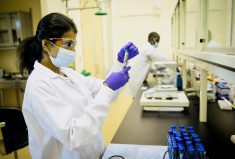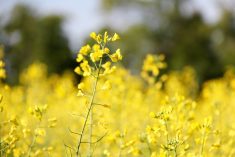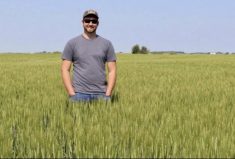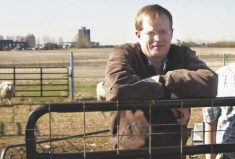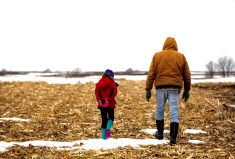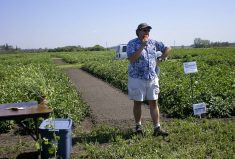Having bees around your canola field might be good for your yield, but the exact details of how and why are not known yet.
That’s where people like Shelley Hoover, apiculture researcher with Alberta Agriculture and Forestry in Lethbridge, comes in. Hoover’s research deals with bee health, bee pollination, and the impacts bees have on crops.
Honeybee populations across Canada are at record levels and honeybee populations are not declining, said Hoover.

“We do, in fact, have more honeybee colonies in Canada than we have ever had before,” she said at the canola Science-O-Rama event here earlier this month.
Like many industries, the bee industry has consolidated — the number of beekeepers has decreased, the number of hives managed by these beekeepers has grown.
“In Alberta, we have close to 300,000 colonies, and we fluctuate between 40 to 45 per cent of all the honeybee colonies in Canada,” said Hoover. “The Prairies produce about 80 per cent of Canada’s honey, so it really is a western industry.”
Canola has been the driving factor on the Prairies, while blueberry pollination is a growing industry in Ontario, Quebec and the Maritimes.
Canola honey is a desirable product on the world market, because of its abundance and Canada’s high food safety standards, said Hoover.
Read Also

New crop insurer policy enables easier startup for faba beans
Agriculture Financial Services Corporation updated its normals for faba beans, which may open the door for more Canadian producers to feel comfortable growing the pulse crop in the future.
“Canola honey is a very light-coloured honey,” she said. “Light colour means that it is high value, because it can be blended with darker honeys or stronger-flavoured honeys. As an export commodity, it’s a very valuable one.”
Honeybees can make honey from both commodity and seed, but in the latter they’re competing with leafcutter bees.
“They can get anywhere from 50 to several hundred pounds of honey per colony from a commodity crop,” said Hoover. “For seed canola, they would get a lot less, partially because of the plants themselves, but also because the stocking rate is high.”
Seed crop fields contain both male fertile plants and male sterile (or female) plants, and bees are needed to get the pollen from the male fertile plant to the infertile plant. About 95 per cent of the seed yield is attributed to bee pollination.
Hoover has been working with graduate students to look at pollinator abundance, distribution across fields, and how that influences pollination. Wind distribution and self-pollination also play a role in canola yields, and a third aspect to consider is pollinator efficiency.
“There are a number of studies that look at whether bees contribute to the yield of commodity canola, but there’s a huge range of answers,” said Hoover.
A recent study from Quebec compared plants grown in cages where they could self-fertilize, plants grown in cages where they could receive wind pollination but no insect pollination, and plants grown in plots with different levels of bees (1.5 colonies per hectare and three colonies per hectare).
“What they found in terms of seed weight per area was that there was a large difference between self-pollination and wind pollination,” said Hoover.
Canola pollinated by wind pollination received a huge bump in yield, while plants pollinated by bees had an even bigger increase.
“In this case, the bees were increasing the yield in terms of grams of seed per metre squared,” said Hoover.
After crunching the numbers, the researchers found seed yields could increase 46 per cent with a stocking rate of three hives per hectare. However, this would require 25 million honeybee colonies, an unattainable number.
But the Quebec study has spurred Hoover and her team to do some new trials on bee, wind pollination and stocking rates, but the results have not yet been completed.




